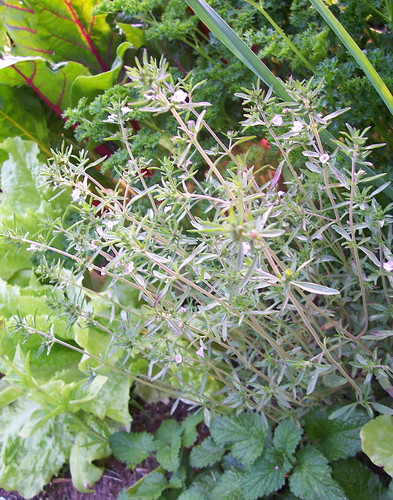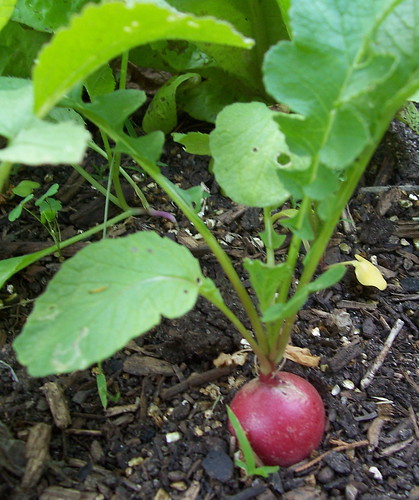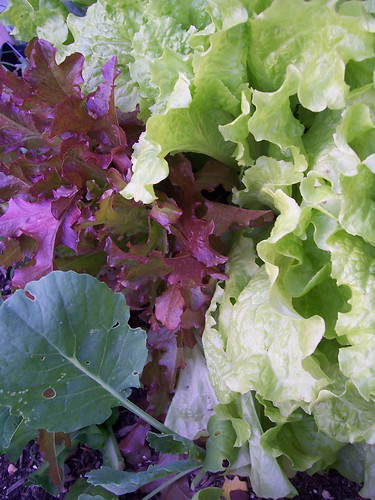
Colors serve all sorts of important biological purposes. Mating, hiding, getting caught, attracting pollinators, warning off predators... in the world of garden vegetables, color means "Eat me! I'm full of cancer-fighting anti-oxidants!" (Aside: I like when vegetables use big words like anti-oxidant. I imagine them pronouncing it with an endearing speech impediment or a funny foreign accent).
HWWLLB and I certainly spend more time looking at our vegetables than we do eating them. Not to say that we don't eat them, we do, but we spend an embarassing amount of time gazing fondly at them. I can't take any credit for the delightful rainbow of plants out there; choosing and arranging have mostly been the work of the man of the house. Mainly I pick and eat them. But seeing as how we have such great colors going on out there, I'm starting to think about growing my own dyes.
Wouldn't you love to have a dress the color of this radish?

I'm eyeing the beets that are slowly coming along out there and wondering whether the trimmings from when I eat them (because I intend to gobble up every last beet myself) would produce enough dye for, say, a skein of sock yarn. Hmmm...
T, companion of Shari, brews his own beer, which is a lot like knitting one's own socks and sweaters, I think. This ingenious fellow is now growing his own barley and hops for the beer brewing, which is a lot like raising the sheep yourself (or maybe growing dye plants?). His beers are delicious, by the way, and I find T and his tasty beer quite inspiring. I like the increased integrity of the project that results when you grow constituent parts yourself - not to mention the reduced ecological footprint.
Some dye plants that are also beautiful to grow:
Beets (of course!)
Indigo
Bloodroot
Burdock
Coreopsis
Sweet woodruff
Yarrow
Some of these are plants we already grow in our yard - I've just never thought to put them to work before, besides the usual looking, smelling and tasting good. Maybe I should go find a book on dyeing with plants. Y'all let me know if you have any recommendations!

it won't dye sock yarn, but it sure makes a purty salad
nice garden porn!! those are some beeeeutiful veggies!! and.. nice lady.. they are full of new-tree-ants and anti-ox-a-dants too..(trying to type in the voice of Jerry Lewis... you'll have to use your minds ear...)
ReplyDeletesave the beets for eating. You would think that they and purple cabbage would work, but alas, they do not. Coffee is nice though.
ReplyDeleteGood book: "Dyes from American Native Plants" by Lynne Richards and Ronald J. Tyrle. It's organized by color! Includes the latin and common names for all the plants. Has mordants listed for each plant and the best process to get the color. Oddly enough, the authors are so thorough that chapter 11 in the book is all about plants that produce little or no color....funny.
ReplyDeleteI say go for it. Dyeing yarn and fabrics is soooo fun.
E.
i wonder if the same dyes that work for natural easter egg dyeing would work for yarn? hmmm. i seem to recall seeing a book specifically on this topic for knitters but of course the title escapes me now... i think it's a wonderful idea and nice to multi-task the garden :)
ReplyDeleteYour veggies look fabulous! My friend bought a book on plants for dyes- I'll ask her what it's called.
ReplyDeletehave you visited knitting iris ? i think she's done quite a bit of natural plant dyeing.
ReplyDeletet was honored to be mentioned on your blog. he was all smiles. he is rather inspiring, isn't he? loved this post f. pea. thanks for sharing your thoughts. xo
ReplyDeletethere's a project going on just over the border from here, in Montgomery VT, which is pairing up gardeners with fibre artists for experiments with locally-grown-and processed yarn (they're using a book called 'dyers' garden,' i do believe... damn you, now i can not rid myself of the image of cabbages speaking with thick eastern-european accents and touting their own nutritional values... cheers!!
ReplyDelete